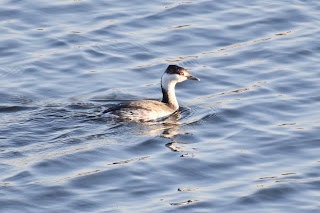Glaucous Gull and Eared Grebe - 1/22 & 1/23
On Sunday afternoon I took my wife for a ride to Island Beach State Park. Except for an abundance of common loons and a half dozen razorbills, it was a blasé day for birding along the beach. However, a little change up greeted us when we reached the beach end at the inlet jetty. A couple hundred gulls, mostly herring, gathered there, many on the water and many on the jetty. Almost immediately, I spotted an all-white gull, amongst the white-and-gray gulls, sitting on the water near the jetty. I pointed it out to my wife and then identified it as a Glaucous gull. I explained to her that it was one of the two white-winged gull species that can show up this time of year, the other being Iceland gull. I pointed out the difference that these gulls lack the black wing tips that all the other gulls around us had. It was 13 months since I last saw a Glaucous gull. My wife was with me that day too when we saw one flying along the beach in nearly the same spot.
I had a handful of the usual gulls: herring, great-black backed and ring-billed, but only one Bonaparte’s. Gannets, which don’t seem to disappoint in windy winter weather, were present and displaying their smooth flight agility. Their bodies are aerodynamically built to glide effortlessly for seemingly long distances over the water in such conditions.
I made out a few dozen of the regular winter sea ducks: surf scoters, black scoters and long-tailed ducks. The actual number present was likely many more, but the unaccounted ones were lost in the troughs between the swells. I tallied ten razorbills on the water and had one dovekie fly by my line of sight, only to disappear behind a wave. I’m sure it landed on the water somewhere in the area, exactly where though remained a mystery.
My surprise for the day was an eared grebe. Despite being the most common grebe in the world, eared grebes are rare here. When I first saw the grebe, I was going to dismiss it as the more locally common, and expected, horned grebe. Both grebes are very similar in basic plumage. With a better look the second time it appeared; I noticed a much darker face than what a basic plumage horned grebe should have. My thoughts immediately turned to it being an eared grebe. The third time it came in to view I was able to get some photos, which was lucky for me, as it dove underwater, and I never located it again.
When I reviewed my photos I was able to make out three field marks identifying it as an eared grebe: it did not have a clean demarcation along the eye line separating its dark cap and white cheeks, it had a smudgy cheek extending blow the eye; it had a peaked appearance to its forehead as opposed to a horned grebe’s flatter looking head; and its bill was thinner and appeared as if it was slightly upturned near the tip.












Comments
Post a Comment